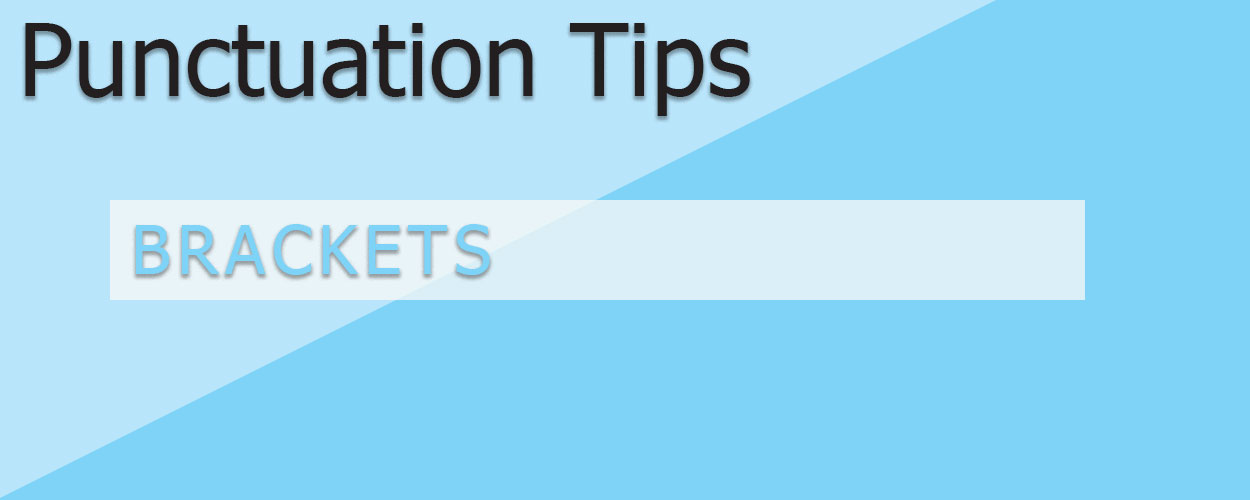Posted: August 15, 2023
Definition: a punctuation mark; a pair of square brackets [ ] used to set apart certain words and sentences, mainly in quotations to add extra information that wasn’t in the original quote.
Note: Do not rely on grammar or spelling checkers to identify missing or misused punctuation. Although a checker may flag possibly missing or incorrect marks, it cannot do much else. While I still recommend using these AI checkers while you’re writing, I insist that you also trust a qualified human being to copyedit any work that you are working toward publishing.
Not to be confused with parentheses ( ), chevrons < >, or braces { }. A bracket, usually coming in opening and closing pairs, are mainly used in non-fiction and academic writing when adding additional information or making edits to quoted material. They are rarely, if ever, seen in fiction.
[Related Article: Punctuation: Parentheses]
To Enclose Parenthetical Material:
Use brackets to enclose publishing information that falls within parentheses.
- e.g. William Shakespeare has written notable works in the tragicomedy genre such as The Tempest and Merchant of Venice. (For further discussion of tragicomedies see Subha Mukherji and Raphael Lyne, Early Modern Tragicomedy [Boydell & Brewer, 2007.].)
Use brackets to enclose parenthetical material that falls within parentheses (like when using single quotes and double quotes together).
- e.g. William Shakespeare has written notable works in the tragicomedy genre such as The Tempest. (For another fine example, read Endgame, by Samuel Beckett. [Beckett was an Irish author and playwright in the mid 1900s.])
Used to Enclose Editorial Comments or Explanations:
Use brackets to identify a person, place, or thing not clear from quoted material.
- e.g. Herbert told Times magazine, “They [the event staff] were prepared for any mishap.”
- e.g. “[Our reliance on foreign oil] will be our undoing,” Margot Simmons told Metropolitan news.
Note: The original word can be left in (above) or be replaced (below) by the bracketed material.
Use brackets to enclose the word sic in quoted material. Sic (Latin for “in this manner” or “thus”) is used to let stand an error that appeared in quoted material.
- e.g. Maggie read him the passage: “While the children ate their brekfast [sic], Mother packed their lunches.”
Note: Sic is usually italicized, but you don’t have to italicize it when in brackets.
Use brackets to comment on quoted material.
- e.g. “The greatest glory in living lies not in never falling, but in rising every time we fall.” Nelson Mandela [Italics mine.]
Used Typographically:
Use brackets to set off phonetical transcriptions.
- e.g. The word white written phonetically is [wIEt].
Use brackets for “continued” lines.
- e.g. [To be continued]
- e.g. [Continued on page 35]
Note: Parentheses can be used for this purpose instead of brackets.
Use brackets to set off reference numbers to a bibliography.
- e.g. According to Gregson [4], …
Note: Here, too, parentheses can be used instead of brackets.
Use brackets in mathematics according to specific rules (not to be laid out here).
With Other Punctuation:
Use punctuation with brackets in the same way as with parentheses.
Do not use punctuation with “continued” lines.
For further information, see my other Punctuation articles:
Sources:
Aaron, J.E. & Morrison, A. The Little, Brown Compact Handbook, 5th Canadian ed. Pearson, 2013, chap 5
Judd, K. Copyediting, A Practical Guide, 3rd ed. California, CA: Crisp Learning, 2001, chap 4

